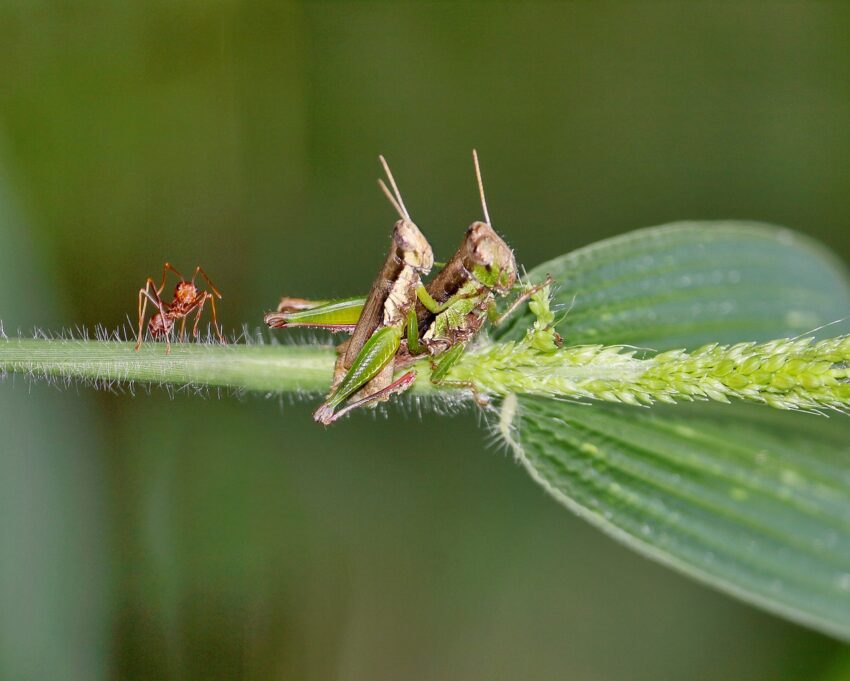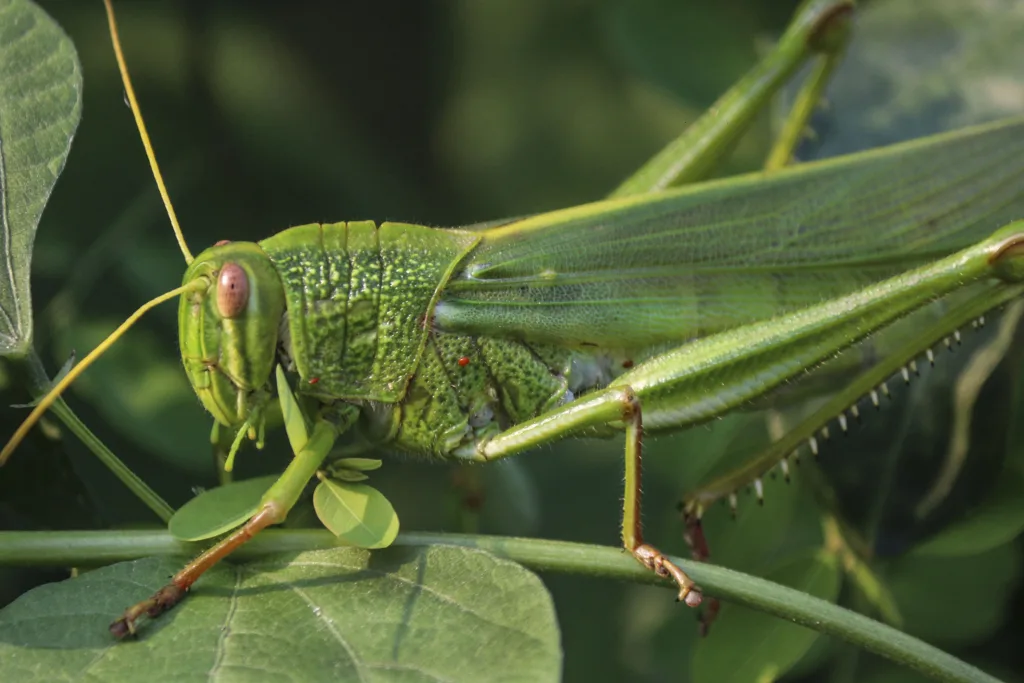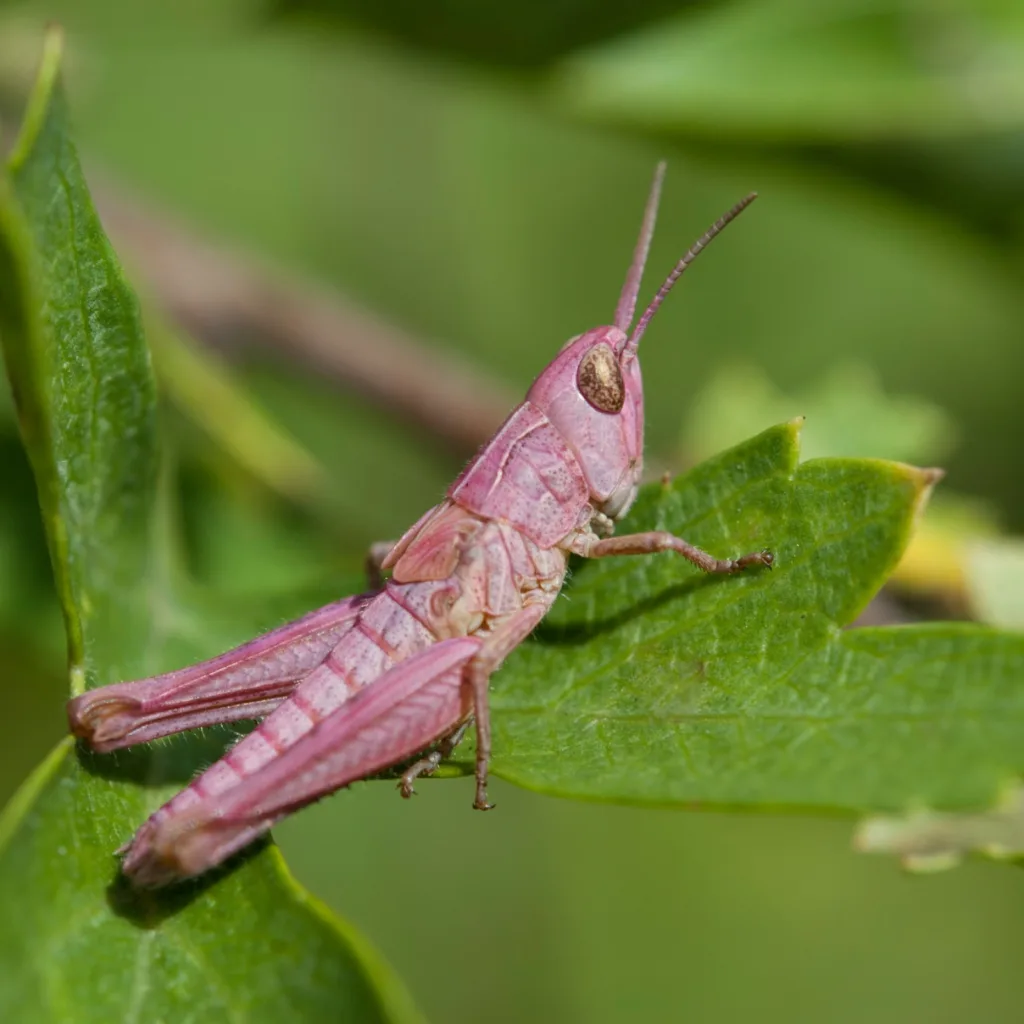Have you ever wondered if grasshoppers have wings? Well, the answer is yes, they do! Although they are well-known for their impressive jumping abilities, grasshoppers are also capable of flying.
Grasshoppers belong to the order Orthoptera, which includes other insects like crickets and katydids. All of these insects have wings, but not all of them are capable of flight. Grasshoppers, however, have strong wings that allow them to travel long distances in search of food and mates.
The wings of a grasshopper are located on its thorax, which is the middle part of its body. There are two pairs of wings, with the front pair being narrow and tough, while the hind pair is wide and flexible. The front pair of wings are called tegmina, and they serve as a protective covering for the hind wings.
When a grasshopper prepares to fly, it flexes its wings and begins to vibrate them rapidly. This motion creates lift, which causes the grasshopper to take flight. Once in the air, grasshoppers can fly for long periods of time, sometimes traveling up to sveral kilometers before landing.
It’s important to note that not all grasshoppers are equally skilled at flying. Some species, like the Carolina grasshopper, are better fliers than others. Additionally, young grasshoppers, known as nymphs, are not able to fly until they have fully matured.
Grasshoppers do indeed have wings, and they are capable of flying. So the next time you see a grasshopper, remember that there’s more to these insects than just their impressive jumping skills.
Do Grasshoppers Have Wings for Flight?
Yes, grasshoppers do have wings that allow them to fly. While they are known for their impressive jumping abilities, grasshoppers also have wings that are located on their thorax. These wings are typically folded neatly against the grasshopper’s body when they are not being used. When a grasshopper needs to fly, it will extend its wings and use them to propel itself through the air. Grasshoppers are actually quite good at flying and can travel long distances in search of food or mates. So, while they may be famous for their jumping, grasshoppers are also skilled fliers.

Types of Winged Grasshoppers
Among the different types of grasshoppers, there is a subdivision called banded-winged grasshoppers that possess wings. These grasshoppers are also known as short-horned grasshoppers and belong to the family Acrididae. One of the most common species of banded-winged grasshoppers is the Carolina grasshopper, which is found in the southeastern region of the United States. These grasshoppers have a distinctive banding pattern on their wings, which helps them to camouflage in their natural habitat. Banded-winged grasshoppers have short antennae, large hind legs, and are capable of jumping long distances.
Number of Wings on a Grasshopper
Grasshoppers have two pairs of wings, making a total of four wings. The front pair of wings is known as the tegmina, which is thick and leathery, while the hind pair of wings is membranous and used for flight. The tegmina wings protect the hind wings and the grasshopper’s body from damage. When the grasshopper takes flight, both pairs of wings are used, with the hind wings providing the main lift and the front wings assisting in the airfoil.
Do Green Grasshoppers Have Wings?
Yes, green grasshoppers have wings. Grasshoppers, including the green ones, have two pairs of wings, one narrow and tough, and the other wide and flexible. The narrow and tough wings, called tegmina, are located on the front of the grasshopper’s body and cover the hind wings when they are not in use. The wide and flexible wings, called hind wings, are located on the back of the grasshopper’s body and are used for flying. The hind wings are folded underneth the tegmina when the grasshopper is not flying. So, in short, green grasshoppers do have wings, which they use for flying and jumping.
Identifying a Bug That Looks Like a Grasshopper But Flies
The bug that looks like a grasshopper but flies is called a katydid. Katydids are part of the same family as crickets and grasshoppers, but they have a few distinct features that set them apart. Unlike grasshoppers, katydids have very long and thin antennae, which can be even longer than their bodies. They also have a more rhomboidal body shape, with four equal-length sides that resemble a kite. Katydids are equipped with wings and are able to fly away from danger, unlike crickets which are not able to fly. These bugs are often green in color, which helps them blend in with their surroundings, and they are knon for their loud, distinctive mating calls that can be heard on summer evenings.

Can Grasshoppers Bite Humans?
Yes, a grasshopper can bite you. However, it is not a common occurrence as grasshoppers are generally not aggressive towards humans. Some types of grasshoppers, particularly those that gather in large swarms, may bite when swarming. This behavior is believed to be a defense mechanism against predators. Additionally, some types of grasshoppers may bite if they feel threatened or provoked. It’s worth noting that grasshopper bites are not poisonous and are not considered dangerous to humans. If you do get bitten by a grasshopper, the bite may be slightly painful, but it should heal on its own wthout the need for medical attention.
Can Grasshoppers Fly Like Butterflies?
While both grasshoppers and butterflies have wings and are capable of flight, their flight patterns and styles differ significantly. Grasshoppers, such as the Carolina grasshopper, are strong fliers and are oftn seen hovering or engaging in a zigzag, fluttering flight during courtship. They are known for their ability to fly quickly and powerfully, and their flight is often compared to that of a small airplane. In contrast, butterflies are delicate fliers that typically glide and float through the air, using their wings to catch the wind and stay aloft. While both grasshoppers and butterflies are fascinating insects to observe in flight, their flight styles are distinct and easily distinguishable.
Distinguishing Between Grasshoppers and Locusts
A grasshopper and a locust can be differentiated based on their physical characteristics and behavior. Grasshoppers generally have shorter wings and larger bodies compared to locusts. They also have a solitary behavior and do not swarm like locusts. On the other hand, locusts have longer and stronger wings, and smaller bodies. They always swarm and can travel over long distances, unlike grasshoppers. Additionally, locusts have a distinctive coloration with yellow, brown, and green hues, while grasshoppers come in a variety of colors including green, brown, and gray. These physical and behavioral differences can help in distinguishing betwen a grasshopper and a locust.
Comparing Locusts and Grasshoppers
Locusts and grasshoppers are both members of the same family, but they have some distinct differences. Grasshoppers are solitary insects that are usually found hopping around in fields or meadows. They have a relatively harmless impact on crops and vegetation. On the other hand, locusts are a small subset of grasshopper species that undergo a remarkable transformation when they enter a swarming phase. During this phase, they can becme highly destructive and cause significant damage to crops and vegetation.
The primary difference between locusts and grasshoppers is their behavior. In their solitary phase, both locusts and grasshoppers are similar in appearance and behavior. However, when locusts enter their swarming phase, they undergo a dramatic transformation. They change their color, shape, and behavior, and their population explodes. Locusts can travel long distances in search of food, and they can consume vast amounts of vegetation in a short period of time. This behavior can cause significant damage to crops and vegetation, leading to famine and economic losses in affected regions.
In summary, all locusts are grasshoppers, but not all grasshoppers are locusts. Grasshoppers are usually solitary and have a relatively benign impact on crops and vegetation. Locusts, on the other hand, are a small subset of grasshopper species that undergo a dramatic transformation when they enter a swarming phase. During this phase, they can become highly destructive and cause significant damage to crops and vegetation.
The Name of a Flying Grasshopper
A flying grasshopper is commonly known as a bird grasshopper. It is a type of grasshopper that can fly and jump very well. However, when grasshoppers go through a migratory phase and form large swarms, they are referred to as locusts. Bird grasshoppers are often found in shrubs or trees, but they also visit the ground. They are known for their excellent jumping abilities and are considered to be adept fliers as well.
Do Grasshoppers Have a Heart?
Yes, grasshoppers do have a heart, which is a muscular organ that pumps their blood or hemolymph throughout their body. However, the circulatory system of grasshoppers is differnt from that of humans, as they have an open circulatory system. This means that their hemolymph flows freely throughout their body cavity and bathes their organs and tissues directly. The grasshopper’s heart is a simple tubular structure with several openings, which allows hemolymph to enter and exit the heart. In contrast, the human heart is a complex, four-chambered organ that pumps blood through a closed circulatory system, where blood is confined to blood vessels.
The Ability of Grasshoppers to Fly or Jump
Grasshoppers are capable of both flying and jumping. They have powerful hind legs that allow them to jump long distances, but they also have wings that enable them to fly. In fact, many species of grasshoppers are skilled fliers and will use their wings to escape danger or travel long distances. While their jumping ability is impressive, it mainly serves as a way to launch themselves into the air before they take flight. So, to answer the question, grasshoppers are both jumpers and fliers.
Identifying a Large Winged Grasshopper
The big grasshopper with wings that you may be referring to is likely the desert lubber grasshopper. These grasshoppers are known for their large and chunky size, and their distinctive black and yellow bodies. In addition, when they fly, they flash bright red wings, making them even more eye-catching. These grasshoppers are commonly found in desert regions and are known for their slow movements and strong legs, which allow them to jump great distances. Overall, the desert lubber grasshopper is a unique and fascinating insect that is easily recognizable due to its size and striking colors.
The Rarest Color of Grasshopper
The rarest color of grasshopper is pink. This is due to an unusual genetic mutation called erythrism, which results in a blushing color. National Geographic reports that this coloration is typically seen in the common meadow grasshopper species. While grasshoppers can come in a variety of colors including green, brown, and yellow, the pink morph is considered to be the rarest. It is a fascinating example of how genetic mutations can lead to unique and unexpected traits in different organisms.

Do Grasshoppers Experience Pain?
The question of whether grasshoppers can feel pain is still a matter of debate among scientists. While it is known that insects, including fruit flies, experience a form of pain called “nociception,” which triggers a response to harmful stimuli, it is not entiely clear whether this can be characterized as true pain as experienced by humans and other animals with complex nervous systems.
Some researchers argue that insects lack the necessary neural structures to experience pain as we understand it. Others point to evidence that suggests grasshoppers and other insects may exhibit behaviors consistent with pain, such as avoiding noxious stimuli and exhibiting defensive reactions.
Overall, while the answer is not definitive, it is likely that grasshoppers and other insects do experience some form of nociception or aversive response to harmful stimuli, though whether this can be classified as true pain is still a matter of scientific inquiry.
Conclusion
In conclusion, grasshoppers are not just able to jump, but they also have wings that allw them to fly. Their wings are strong enough to carry them long distances in search of food and mates. Grasshoppers belong to the short-horned grasshopper family, and like all insects, they have a three-part body consisting of a head, thorax, and abdomen. With their six legs, two pairs of wings, and two antennae, grasshoppers are medium to large insects with lengths that vary depending on the species. So, it can be said that grasshoppers are not just fascinating creatures to observe, but they are also impressive fliers.
